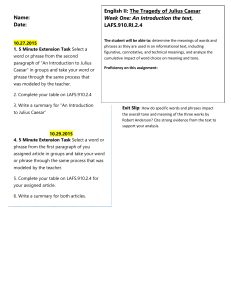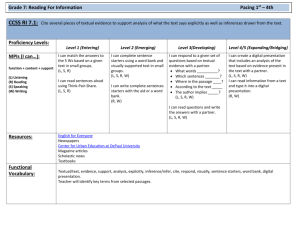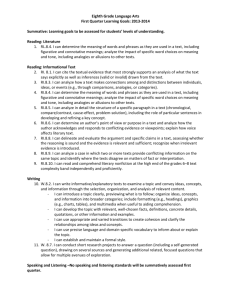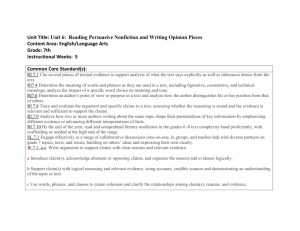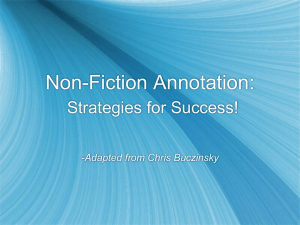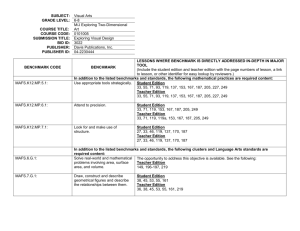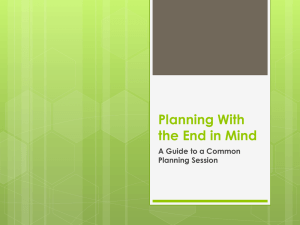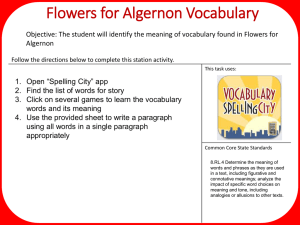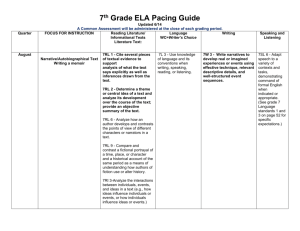Lesson Plans
advertisement
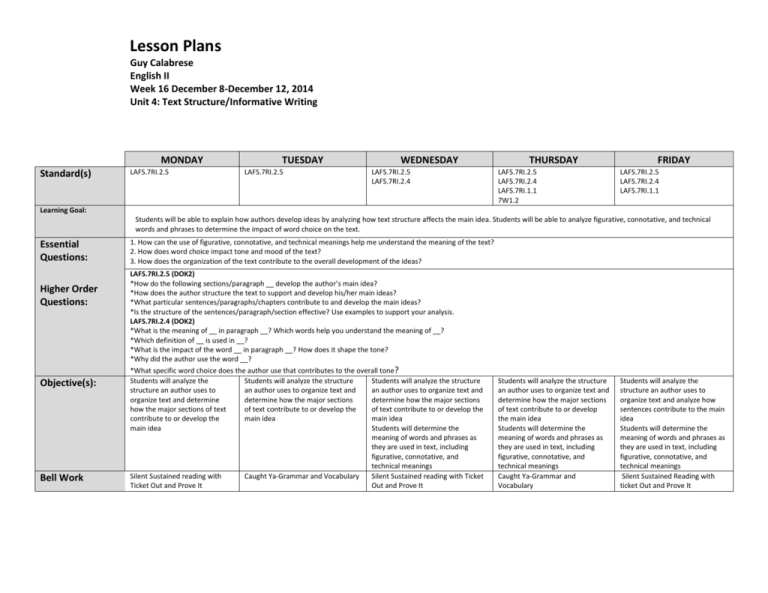
Lesson Plans Guy Calabrese English II Week 16 December 8-December 12, 2014 Unit 4: Text Structure/Informative Writing MONDAY Standard(s) LAFS.7RI.2.5 TUESDAY LAFS.7RI.2.5 WEDNESDAY LAFS.7RI.2.5 LAFS.7RI.2.4 THURSDAY LAFS.7RI.2.5 LAFS.7RI.2.4 LAFS.7RI.1.1 7W1.2 FRIDAY LAFS.7RI.2.5 LAFS.7RI.2.4 LAFS.7RI.1.1 Learning Goal: Students will be able to explain how authors develop ideas by analyzing how text structure affects the main idea. Students will be able to analyze figurative, connotative, and technical words and phrases to determine the impact of word choice on the text. Essential Questions: Higher Order Questions: Objective(s): Bell Work 1. How can the use of figurative, connotative, and technical meanings help me understand the meaning of the text? 2. How does word choice impact tone and mood of the text? 3. How does the organization of the text contribute to the overall development of the ideas? LAFS.7RI.2.5 (DOK2) *How do the following sections/paragraph __ develop the author’s main idea? *How does the author structure the text to support and develop his/her main ideas? *What particular sentences/paragraphs/chapters contribute to and develop the main ideas? *Is the structure of the sentences/paragraph/section effective? Use examples to support your analysis. LAFS.7RI.2.4 (DOK2) *What is the meaning of __ in paragraph __? Which words help you understand the meaning of __? *Which definition of __ is used in __? *What is the impact of the word __ in paragraph __? How does it shape the tone? *Why did the author use the word __? *What specific word choice does the author use that contributes to the overall tone? Students will analyze the Students will analyze the structure Students will analyze the structure structure an author uses to an author uses to organize text and an author uses to organize text and organize text and determine determine how the major sections determine how the major sections how the major sections of text of text contribute to or develop the of text contribute to or develop the contribute to or develop the main idea main idea main idea Students will determine the meaning of words and phrases as they are used in text, including figurative, connotative, and technical meanings Silent Sustained reading with Caught Ya-Grammar and Vocabulary Silent Sustained reading with Ticket Ticket Out and Prove It Out and Prove It Students will analyze the structure an author uses to organize text and determine how the major sections of text contribute to or develop the main idea Students will determine the meaning of words and phrases as they are used in text, including figurative, connotative, and technical meanings Caught Ya-Grammar and Vocabulary Students will analyze the structure an author uses to organize text and analyze how sentences contribute to the main idea Students will determine the meaning of words and phrases as they are used in text, including figurative, connotative, and technical meanings Silent Sustained Reading with ticket Out and Prove It Agenda/Activities We Do: Review text structures and discuss the text structure for “All Together Now” You Do: Find the evidence in the text that supports the text structure by identifying the key words Continue Critical Thinking Questions p. 496 Complete Reading Skill: Classifying fact and Opinion I Do: We Do: You Do: Analyze the text’s structure by determining and describing the role of sentences and paragraphs in the text (determine why that sentence and paragraph is included in the article) Introduce RACE by using article, “All Together Now” by Barbara Jordan I Do: Model how to turn the following question into a statement: How does the text structure help support the author’s main point that people need to come together to create a tolerant society? Breakdown the paragraph into RACE We Do: Create the Race paragraph Students will be grouped and given 3 paragraphs to discuss. After the paragraphs are given, students will choose a sentence a specific sentence of importance Complete Literary Analysis: Determining the persuasive technique and most convincing argument Vocabulary Homework Accommodations Text structure, central idea, details, figurative meaning, connotative meaning, technical words, tone, mood, analogies, allusions, informative/ explanatory texts, transitions --AR Reading --Complete any unfinished You Do assignments. Text structure, central idea, details, figurative meaning, connotative meaning, technical words, tone, mood, analogies, allusions, informative/ explanatory texts, transitions --AR Reading --Complete any unfinished You Do assignments. Text structure, central idea, details, figurative meaning, connotative meaning, technical words, tone, mood, analogies, allusions, informative/ explanatory texts, transitions --AR Reading --Complete any unfinished You Do assignments. Students will complete the following steps in preparation for RACE paragraph answering the question How does the text structure help support the author’s main point about how Harry McAlpin struggled to break down racial barriers in 1944 and gain success? : students will read through the article and highlight any struggles that McAlpin faced and any successes that McAlpin achieved Students come together in groups and write down successes and struggles on chart paper and Discuss the text structure that the author uses to highlight the struggles and successes of McAlpin Text structure, central idea, details, figurative meaning, connotative meaning, technical words, tone, mood, analogies, allusions, informative/ explanatory texts, transitions --AR Reading --Complete any unfinished You Do assignments. I DO: Review over RACE strategy You Do: students will answer the question How does the text structure help support the author’s main point about how Harry McAlpin struggled to break down racial barriers in 1944 and gain success? Text structure, central idea, details, figurative meaning, connotative meaning, technical words, tone, mood, analogies, allusions, informative/ explanatory texts, transitions --AR Reading --Complete any unfinished You Do assignments. 504 Accommodations: 3rd and 6th Extended time for class and standardized testing; 4th Additional time on test and test in small group 4th On standardized tests, read test questions and give flexible preferred seating 4th test in alternative setting and extended time not to exceed one day 6th Refocus to task ESE Accommodations: 1st Extended time for 24 hours for assignments, repeat and clarify, and ensure understanding of directions, Read directions aloud and check for understanding, provide visual and verbal cues, check for comprehension of read material, provide copy of notes, Preferential setting, Allow student to read aloud to self 2nd in addition to accommodations listed for 1st also test directions read aloud and clarified and leave class for assistance, read allowable test questions, prompt to stay on task, provide preferential seating, JS allow breaks and fluid, and warm clothing 3rd Extended time for class and standardized testing; test in alternative setting, leave class for assistance, frequent breaks 4th test with familiar person, leave class for assistance, student demonstrates understanding of directions
